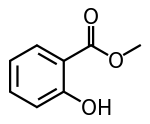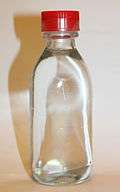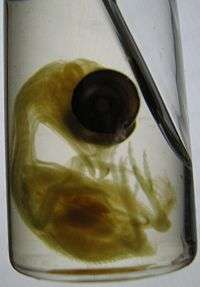Methyl salicylate
Methyl salicylate (oil of wintergreen or wintergreen oil) is an organic compound with the formula C6H4(OH)(CO2CH3). It is the methyl ester of salicylic acid. It is a colorless, viscous liquid with a sweet, fruity odor reminiscent of root beer, but often associatively called "minty," as it is an ingredient in mint candies.[4] It is produced by many species of plants, particularly wintergreens. It is also produced synthetically, used as a fragrance, in foods and beverages, and in liniments.
 | |||
| |||
 | |||
| Names | |||
|---|---|---|---|
| IUPAC name
Methyl 2-hydroxybenzoate | |||
Other names
| |||
| Identifiers | |||
3D model (JSmol) |
|||
| ChEBI | |||
| ChEMBL | |||
| ChemSpider | |||
| ECHA InfoCard | 100.003.925 | ||
| EC Number |
| ||
| KEGG | |||
PubChem CID |
|||
| RTECS number |
| ||
| UNII | |||
CompTox Dashboard (EPA) |
|||
| |||
| |||
| Properties | |||
| C8H8O3 | |||
| Molar mass | 152.149 g·mol−1 | ||
| Appearance | Colorless liquid | ||
| Odor | sweet, rooty | ||
| Density | 1.174 g/cm3 | ||
| Melting point | −8.6 °C (16.5 °F; 264.5 K) | ||
| Boiling point | 222 °C (432 °F; 495 K) [1] Decomposes at 340–350 °C[2] | ||
| 0.639 g/L (21 °C) 0.697 g/L (30 °C)[2] | |||
| Solubility | Miscible in organic solvents | ||
| Solubility in acetone | 10.1 g/g (30 °C)[2] | ||
| Vapor pressure | 1 mmHg (54 °C)[1] | ||
| Acidity (pKa) | 9.8[3] | ||
| −8.630×10−5 cm3/mol | |||
Refractive index (nD) |
1.538 | ||
| Hazards | |||
| Main hazards | Harmful | ||
| GHS pictograms |  | ||
| GHS Signal word | Warning | ||
GHS hazard statements |
H302[1] | ||
| P264, P270, P280, P301+312, P302+352, P305+351+338, P321, P330, P332+313, P337+313, P362, P501 | |||
| NFPA 704 (fire diamond) | |||
| Flash point | 96 °C (205 °F; 369 K) [1] | ||
| 452.7 °C (846.9 °F; 725.8 K)[1] | |||
Except where otherwise noted, data are given for materials in their standard state (at 25 °C [77 °F], 100 kPa). | |||
| Infobox references | |||
Biosynthesis and occurrence
Methyl salicylate was first isolated (from the plant Gaultheria procumbens) in 1843 by the French chemist Auguste André Thomas Cahours (1813–1891), who identified it as an ester of salicylic acid and methanol.[5][6]
The biosynthesis of methyl salicylate arises via the hydroxylation of benzoic acid by a cytochrome P450 followed by methylation by a methylase enzyme.[7]
Methyl salicylate is probably produced as an anti-herbivore defense. If the plant is infected with herbivorous insects, the release of methyl salicylate may function as an aid in the recruitment of beneficial insects to kill the herbivorous insects.[8] Aside from its toxicity, methyl salicylate may also be used by plants as a pheromone to warn other plants of pathogens such as tobacco mosaic virus.[9]
Numerous plants produce methyl salicylate in very small amounts. Some plants, such as the following, produce more: some species of the genus Gaultheria in the family Ericaceae, including Gaultheria procumbens, the wintergreen or eastern teaberry; some species of the genus Betula in the family Betulaceae, particularly those in the subgenus Betulenta such as B. lenta, the black birch; all species of the genus Spiraea in the family Rosaceae, also called the meadowsweets; species of the genus Polygala in the family Polygalaceae.
Commercial production
Methyl salicylate can be produced by esterifying salicylic acid with methanol.[10] Commercial methyl salicylate is now synthesized, but in the past, it was commonly distilled from the twigs of Betula lenta (sweet birch) and Gaultheria procumbens (eastern teaberry or wintergreen).
Uses

Methyl salicylate is used in high concentrations as a rubefacient and analgesic in deep heating liniments (such as Bengay) to treat joint and muscular pain. Randomised double blind trials report that evidence of its effectiveness is weak, but stronger for acute pain than chronic pain, and that effectiveness may be due entirely to counterirritation. However, in the body it metabolizes into salicylates, including salicylic acid, a known NSAID.[11][12][13]
Methyl salicylate is used in low concentrations (0.04% and under)[14] as a flavoring agent in chewing gum and mints. When mixed with sugar and dried, it is a potentially entertaining source of triboluminescence, gaining the tendency to build up electrical charge when crushed or rubbed, which can be observed by crushing wintergreen Life Savers in a dark room.[15][16] It is used as an antiseptic in Listerine mouthwash produced by the Johnson & Johnson company.[17] It provides fragrance to various products and as an odor-masking agent for some organophosphate pesticides.
Methyl salicylate is also used as a bait for attracting male orchid bees for study, which apparently gather the chemical to synthesize pheromones,[18] and to clear plant or animal tissue samples of color, and as such is useful for microscopy and immunohistochemistry when excess pigments obscure structures or block light in the tissue being examined. This clearing generally only takes a few minutes, but the tissue must first be dehydrated in alcohol.[19]
Additional applications include: used as a simulant or surrogate for the research of chemical warfare agent sulfur mustard, due to its similar chemical and physical properties.[20], in restoring (at least temporarily) the elastomeric properties of old rubber rollers, especially in printers, [21] and as a penetrating oil to loosen rusted parts.
Safety and toxicity
Methyl salicylate is potentially deadly, especially for young children. A single teaspoon (5 ml) of methyl salicylate contains approximately 6 g of salicylate,[22] which is equivalent to almost twenty 300 mg aspirin tablets (5 ml × 1.174 g/ml = 5.87 g). Toxic ingestions of salicylates typically occur with doses of approximately 150 mg/kg body weight. This can be achieved with 1 ml of oil of wintergreen, which equates to 140 mg/kg of salicylates for a 10 kg child (22 lbs).[23] The lowest published lethal dose is 101 mg/kg body weight in adult humans,[24] (or 7.07 grams for a 70 kg adult). It has proven fatal to small children in doses as small as 4 ml.[14] A seventeen-year-old cross-country runner at Notre Dame Academy on Staten Island died in April 2007 after her body absorbed methyl salicylate through excessive use of topical muscle-pain relief products.[25]
Most instances of human toxicity due to methyl salicylate are a result of over-application of topical analgesics, especially involving children. Salicylate, the major metabolite of methyl salicylate, may be quantitated in blood, plasma or serum to confirm a diagnosis of poisoning in hospitalized patients or to assist in an autopsy.[26]
Compendial status
See also
References
- Sigma-Aldrich Co., Methyl salicylate. Retrieved on 2013-05-23.
- "Methyl salicylate". chemister.ru.
- Scully, F. E.; Hoigné, J. (January 1987). "Rate constants for reactions of singlet oxygen with phenols and other compounds in water". Chemosphere. 16 (4): 681–694. Bibcode:1987Chmsp..16..681S. doi:10.1016/0045-6535(87)90004-X.
- Cahours, A. A. T. (1843). "Recherches sur l'huile de Gaultheria procumbens" [Investigations into the oil of Gaultheria procumbens]. Comptes Rendus. 16: 853–856.
- Cahours, A. A. T. (1843). "Sur quelques réactions du salicylate de méthylène" [On some reactions of methyl salicylate]. Comptes Rendus. 17: 43–47.
- Vogt, T. (2010). "Phenylpropanoid Biosynthesis". Molecular Plant. 3: 2–20. doi:10.1093/mp/ssp106. PMID 20035037.
- James, D. G.; Price, T. S. (2004). "Field-testing of methyl salicylate for recruitment and retention of beneficial insects in grapes and hops". Journal of Chemical Ecology. 30 (8): 1613–1628. doi:10.1023/B:JOEC.0000042072.18151.6f. PMID 15537163.
- Shulaev, V.; Silverman, P.; Raskin, I. (1997). "Airborne signalling by methyl salicylate in plant pathogen resistance". Nature. 385 (6618): 718–721. Bibcode:1997Natur.385..718S. doi:10.1038/385718a0.
- Boullard, Olivier; Leblanc, Henri; Besson, Bernard (2012). "Salicylic Acid". Ullmann's Encyclopedia of Industrial Chemistry. Weinheim: Wiley-VCH. doi:10.1002/14356007.a23_477.
- "Topical analgesics introduction". Medicine.ox.ac.uk. 2003-05-26. Archived from the original on 2012-08-04. Retrieved 2012-11-07.
- Mason, L.; Moore, R. A.; Edwards, J. E.; McQuay, H. J.; Derry, S.; Wiffen, P. J. (2004). "Systematic review of efficacy of topical rubefacients containing salicylates for the treatment of acute and chronic pain". British Medical Journal. 328 (7446): 995. doi:10.1136/bmj.38040.607141.EE. PMC 404501. PMID 15033879.
- Tramer, M. R. (2004). "It's not just about rubbing--topical capsaicin and topical salicylates may be useful as adjuvants to conventional pain treatment". British Medical Journal. 328 (7446): 998. doi:10.1136/bmj.328.7446.998. PMC 404503. PMID 15105325.
- Wintergreen at Drugs.com
- Harvey, E. N. (1939). "The luminescence of sugar wafers". Science. 90 (2324): 35–36. Bibcode:1939Sci....90...35N. doi:10.1126/science.90.2324.35. PMID 17798129.
- "Why do Wint-O-Green Life Savers spark in the dark?". HowStuffWorks.
- Listerine. "Original Listerine Antiseptic Mouthwash". Retrieved 25 March 2015.
- Schiestl, F. P.; Roubik, D. W. (2004). "Odor Compound Detection in Male Euglossine Bees". Journal of Chemical Ecology. 29 (1): 253–257. doi:10.1023/A:1021932131526. PMID 12647866.
- Altman, J. S.; Tyrer, N. M. (1980). "Filling selected neurons with cobalt through cut axons". In Strausfeld, N. J.; Miller, T. A. (eds.). Neuroanatomical Techniques. Springer-Verlag. pp. 373–402.
- Bartlet-Hunt, S. L.; Knappe, D. R. U.; Barlaz, M. A. (2008). "A Review of Chemical Warfare Agent Simulants for the Study of Environmental Behaviour". Critical Reviews in Environmental Science and Technology. 38 (2): 112–136. doi:10.1080/10643380701643650.
- "MG Chemicals – Rubber Renue Safety Data Sheet" (PDF). Archived from the original (PDF) on 2015-06-26.
- "Salicylate Poisoning – Patient UK". Patient.info. 2011-04-20. Retrieved 2013-07-01.
- Hoffman, R. (2015). Goldfrank's Toxicologic Emergencies (10th ed.). New York, NY: McGraw-Hill. pp. 915–922. ISBN 978-0-07-180184-3.
- Safety data for methyl salicylate Archived 2007-10-13 at the Wayback Machine, Physical & Theoretical Chemistry Laboratory, Oxford University
- "Muscle-Pain Reliever Is Blamed For Staten Island Runner's Death". New York Times. 10 June 2007.
- Baselt, R. (2008). Disposition of Toxic Drugs and Chemicals in Man (8th ed.). Foster City, CA: Biomedical Publications. pp. 1012–1014. ISBN 978-0-9626523-7-0.
- The British Pharmacopoeia Secretariat (2009). "Index, BP 2009" (PDF). Archived from the original (PDF) on 11 April 2009. Retrieved 5 July 2009.
- "NIHS Japan". Moldb.nihs.go.jp. Retrieved 2013-07-01.
External links
| Wikimedia Commons has media related to Methyl salicylate. |


